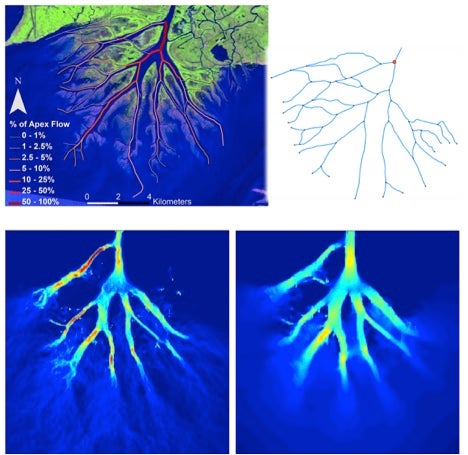 Project Full Title: FESD Type 1: A Delta Dynamics Collaboratory
Project Full Title: FESD Type 1: A Delta Dynamics Collaboratory
Principal Investigator(s): Paola Passalacqua, David Mohrig and Wonsuck Kim.
Researchers: Man Liang, Matt Hiatt
Sponsor(s): National Science Foundation
Full Abstract:
River deltas represent a major Earth-surface system with societal need. Low-lying, ecologically productive, and inhabited by millions of people, deltas also lie directly in the path of a confluence of ongoing changes: nutrient overloading from agriculture; accelerated subsidence and sea-level rise; effects of land use and navigation; and changing hydrology and sediment supply. The overall objective of this proposal is to develop tested, high-resolution, quantitative models incorporating morphodynamics, ecology, and stratigraphy to predict river delta dynamics over engineering to geologic time-scales, and to specifically address questions of system dynamics, resiliency, and sustainability. We will do this by establishing the Delta Dynamics Collaboratory (DDC) for multi-investigator, interdisciplinary investigations of river delta sedimentary and ecologic dynamics. The lead institution for DDC will be the University of Texas, Austin, currently the center of delta prediction efforts for the National Center for Earth-surface Dynamics (NCED). The collaboratory will comprise two main work centers: a field observatory and a virtual modeling center, together with supporting experimental facilities. The observatory will be at Wax Lake Delta, a manageably small (140 km2), actively growing delta about 100 km west of the main Mississippi Delta birdsfoot. The main observational goal will be to create a network of self-activating sensors to monitor delta behavior during major events (storms, river floods) that will complement an intensive survey program to measure ecosystem properties and relate them to high-resolution topography, bathymetry, and flow fields. The virtual modeling center will be hosted by the Community Surface Dynamics Modeling System (CSDMS) at University of Colorado, where it can contribute to an evolving library of modules for computation and visualization of geomorphic and sedimentary systems, including access to many of the existing delta models. These two centers will be supported by experimental programs at the universities of Minnesota, Illinois, and Texas, and computational programs at Penn State, Boston College, Louisiana-Lafayette, Minnesota, Illinois, and Texas.
Given the challenges, and the fact that no predictive ecogeomorphic model for deltas currently exists, there is certainly a risk that we are not as close to creating one as we think. But the return is enormous, not only providing tools that will be used by coastal scientists and managers worldwide, but also potentially providing the scientific basis for dramatically reshaping the US Gulf coast, creating hundreds of km2 of productive new wetlands and helping to protect New Orleans against future storms. The DDC also will include an innovative educational program through collaboration with the UT-Austin, Jackson School of Geosciences GeoFORCE Texas program, the nation’s largest college preparatory program for Earth sciences. At present, 93% of GeoFORCE multi-year participating minority students have gone on to college. DDC will partner with GeoFORCE by providing web-based classroom and lab materials for its high-school Earth sciences program.
